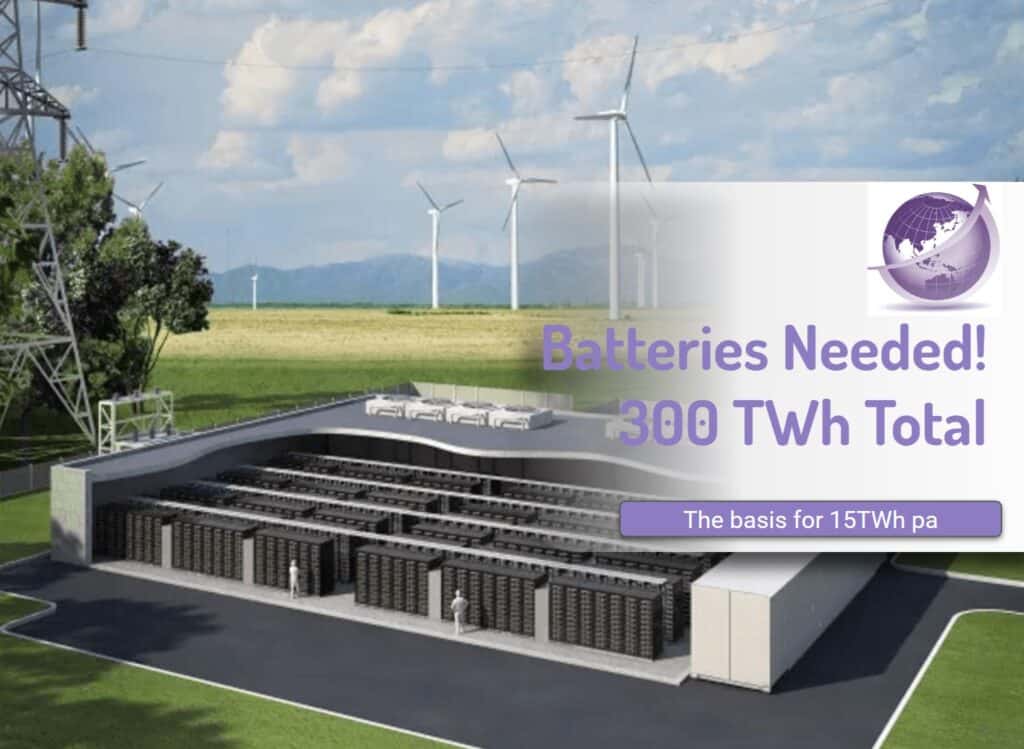The total amount of batteries for electrification is 300TWh according to Elon Musk based on multiple interviews. A recent podcast by Getting Stoned confirms previous numbers provided in this YouTube interview with the Tesla Owners Silicon Valley. Tesla looks to provide about 10% of that battery manufacture. The 300TWh will take ten years to get there, and will require 15TWh per year.
Renewable energy does not provide energy all the time as the sun does not shine al the time, nor does wind blow. While somewhere on earth it does but that requires transmission and some plans are for 4,000 km transmission lines. Moreover, electric vehicles need mobile batteries.
For a million years, humans have burnt rocks (dinosaurs) for heat, cooking and energy. In contrast wind and solar are a technology that captures energy. As the demand is not always matched with supply, energy has to be stored. In batteries, whether they are electrical or pumped hydro. Nuclear is currently only about 8% and cannot be deployed fast enough or the waste problem sorted.
Suggestion Batteries for Electrification is 300TWh
There is no formal paper about the requirement for 300TWh. Musk uses the following:
- Number of cars in the world = 1.2 Billion
- Battery needs for cars @ 75kW, with trucks and rail much higher
- Total EV fleet requirement = 90 TWh of batteries.
- Musk says that grid and home batteries would need to be 2 times that amount.
- Current grid power in globe today = 7,100 GW capacity
- Renewable electricity capacity = 4,800 by 2026
- There are 1 billion people in the world today with energy poverty
- Batteries will be a combination of large installations, and home batteries which will stabilize power in residential areas.
- Batteries last 20 years
- Batteries can be fully recycled
- Remanufacture demand will be about 15GWh per year
Increasing Capacity Number
In 2020 at Battery Day, Musk suggested that 10 TWh of production is need per year, and for 10 to 15 years. Building more factories will enable transition to all-electric transportation and grid storage. He explained how present-day batteries are simply too small and costly to provide 20 TW per year. Current Tesla production is now about 1TWh (2022) with Gigatexas and GigaBerlin coming online in 2022.
Announced battery gigafactories capacity exceed 3,000 GWh of production planned or in construction. See the numbers here, and for USA China or Europe.
Increasing Grid Scale Battery Capacity
- 2017, 30MWh battery in California.
- 2018, 100MWh battery in South Australia (now 150MW/300MWh
- 2021 Moss Landing includes 256 Tesla Megapack battery units on 33 concrete slabs and is 185MW/ 730MWh. I.e discharge at a maximum rate of 182.5 megawatts per hour for 4 hours.
IEA Disagrees
The International Energy Agency does not see the world changing as fast as Musk! Nor as Tony Seba from Rethinkx. IEA sees 290GW of new renewable power coming in 2021.
IEA forecast 305 GW per year between 2021 and 2026
if 10% of batteries are required for grid firming that is 30GW per year.
Most of that is going into EV production. Esource forecast that number to be 400 GWh by 2030 from 21GW in 2021. The halving of battery costs will accelerate the rate of adoption.

















